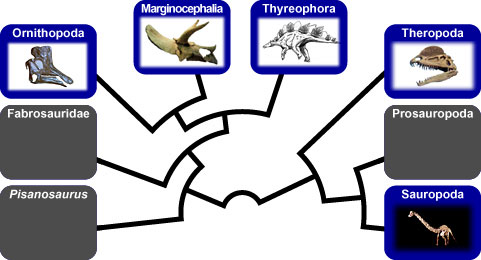



Dinosauria: Systematics
Move deeper into the systematics of dinosaur groups by selecting one of the boxes containing a picture.

With the discovery of many new species since the 1840s, the Dinosauria now contains two major groups of dinosaurs: the Ornithischia, or "bird-hipped" dinosaurs, and the Saurischia, or "lizard-hipped" dinosaurs. The division between the two groups was made by H.G. Seeley in 1888. The etymology behind the two names ("bird-hipped" vs. "lizard-hipped") is not very accurate, since some saurischians had bird-like hips, and ornithischians' hips were somewhat birdlike due to convergent evolution, not due to direct ancestry. In fact, birds are saurischians!
Saurischia contains two main groups:
- Sauropodomorpha is the first group, and includes both the "prosauropods" — a probably paraphyletic (artificial) group of largely herbivorous, dominantly quadrupedal dinosaurs such as Plateosaurus; and the Sauropoda: long-necked, long-tailed, enormous herbivorous dinosaurs like Apatosaurus (formerly called Brontosaurus), Brachiosaurus, and Diplodocus.
- Theropoda is the second saurischian group, consisting of the carnivorous dinosaurs. The Theropoda includes some extinct dinosaurs such as Tyrannosaurus rex and Dilophosaurus, but it also includes the living dinosaurs — the birds.
Ornithischia contains several groups of herbivorous dinosaurs, including several basal groups, but primarily three large ones:
- Thyreophora includes the various armored dinosaurs, like Stegosaurus and Ankylosaurus.
Marginocephalia consists mainly of the pachycephalosaurs (bone-heads) and the ceratopsians (horned dinosaurs), like Triceratops.
Ornithopoda is the third Ornithischian group, and includes not only small bipedal plant-eaters like Heterodontosaurus, but also the often large hadrosaurs, or "duck-billed dinosaurs," like Maiasaura and Edmontosaurus.
Sources:
- Weishampel, D.B., P. Dodson, and H. Osmolska (eds.). 1990. The Dinosauria. University of California Press, Berkeley. 733 pp.